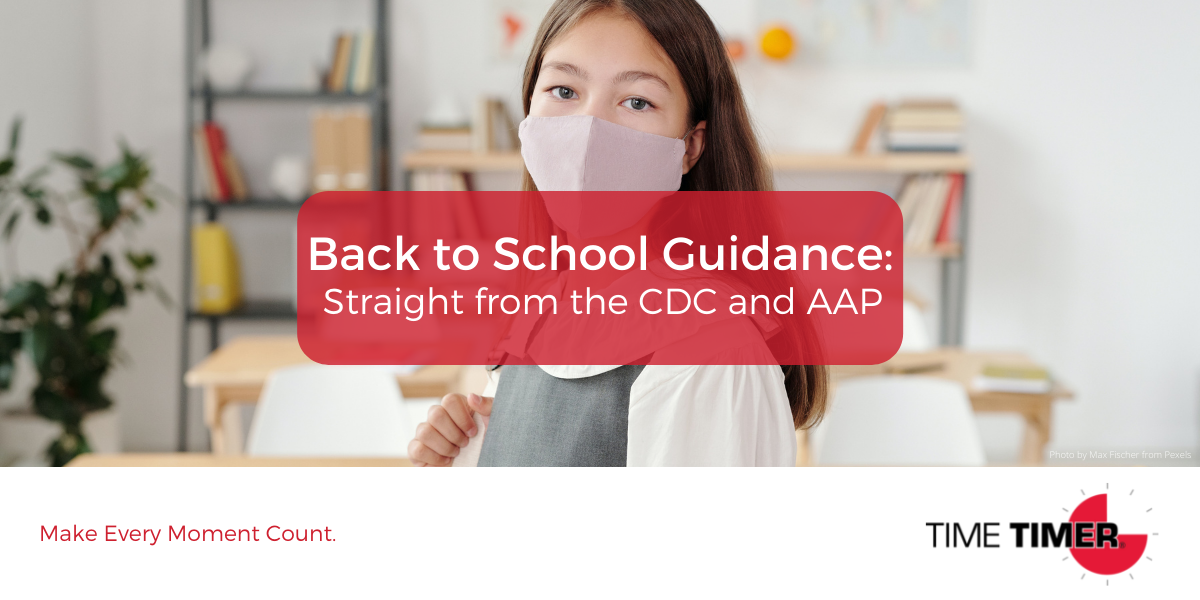We’re one short month away from schools reopening and summer vacation being over. Though this summer was probably much more eventful for you and your kids than the last, we’re not quite out of the woods yet with COVID-19, so we’ll be giving you a quick summary of The American Academy of Pediatrics’ (AAP) guidelines for in-person learning. The AAP actually recommends a return to in-person learning, one of the reasons being that it is probably better for students’ mental health. The rates of COVID transmission among students can be quite low, under the condition that the correct preventative measures are taken. Among these preventative measures is proper handwashing, which we’ll give special focus to in this article, along with how you can include the Time Timer WASH into you and your children’s handwashing routine.
Masks
A ground rule that the AAP set is that students over 2 years of age and school staff should wear masks, even if they are vaccinated. Though your kids probably won’t love this, this rule is part of the “layered approach” of protection that the AAP advocates for, meaning that students and staff have taken multiple COVID-preventing measures, such as wearing a mask even if you are vaccinated.
Vaccination
Speaking of vaccines, it is highly likely that the vaccine will become a requirement, rather than a suggestion, for eligible students (12 years of age and up) in the near future, along with school staff. There is even a possibility that vaccinations will be authorized for students 12 and under by winter break. It is important to note that not all students have access to, or are eligible for, the vaccine, which further justifies the recommended use of masks.
Testing
Mandatory, regular testing can be a costly endeavor for schools, but at the very least a school ought to make testing resources available to their students, and it may be useful to randomly test unvaccinated students in order to catch any potential spreaders. Depending on the rate of positive tests, schools should be prepared to increase the strictness of their strategies (e.g., spacing greater than the currently recommended 3 feet of distance) in order to adjust to the heightened risk. And, of course, quarantining will still be mandatory for those who test positive.
Attendance and Mental Health
As mentioned earlier, the AAP thinks that in-person learning is ultimately beneficial, and worth the risk. Schools should encourage in-person learning over any virtual setting offerings, as the return to in-person learning can be crucial for bettering the mental health of students, and helping them overcome any anxieties or other issues brought unto them by the pandemic, such as agoraphobia or separation anxiety. Mental health services for students and staff will be especially crucial in this upcoming year.
Handwashing
Proper handwashing and hand sanitization (with >60% alcohol sanitizers) will be essential for achieving layered protection. Of course, it is always recommended that students and staff wash their hands before and after eating, using the bathroom, handling garbage, after blowing their nose or sneezing, and being around animals. But regular hand washing will be a must for school safety, and doing so between classes is highly recommended.
Students and staff will be curious as to what constitutes a thorough handwashing. The first thing to understand is that effective hand washing involves correct timing. Simply running your hands under the water won’t suffice. The CDC identifies a 20-second hand washing as the most effective. It won’t be too difficult to meet this standard with a Time Timer WASH timer, which is a touchless device that reinforces 20 seconds of scrubbing recommended by the CDC for clean, germ-free hands. The Timer Timer WASH will guide the user, in three simple steps, soaping, scrubbing, and rinsing through a 20-second hand washing.
The Time Timer WASH can be placed, via suction cup, onto a mirror, or set on the counter of the sink. All that’s needed to start the timer is to hold a hand in front of the Time Timer. The CDC recommends humming the Happy Birthday song twice in order to reach twenty seconds of scrubbing, but we think a Time Timer WASH is a better solution. Besides, you don’t want to ruin the song for yourself when you actually need to sing it.
Additionally, the Time Timer WASH features visual clues and optional music, and alerts that can make hand washing more fun and motivating for students! Its easily understandable instruction can help students with autism, anxiety, germaphobia, or OCD have a much easier experience of practicing good hygiene.
It should be said that washing hands without soap is much less effective in preventing the spread of germs and disease, and this is because soap contains surfactants, which lifts soil and microbes (like germs) from the skin of hands. Another reason is the simple fact that people tend to scrub harder when they use soap, for the sole reason that they want to get the soap off their hands. So, using soap ensures more thorough hand washings that result in cleaner hands.
Lastly, the technique of hand washing ought to cover all the bases: Palms, backs of hands, fingers, knuckles, between fingers, under the nails. Germs can get just about anywhere on hands, and the only way to scrub it away is to apply friction to these areas, under clean running water and soap of course. It’s also important to use a clean towel to wipe your hands. Be sure to frequently clean hand towels at home, because germs accumulate quite easily on them, seeing as how they are used to clean hands.
Bonus: Using the Regular Time Timer at Home!
Generally, washing your hands every half hour or so, no matter what activity you’ve been doing, can be a good preventative measure. We don’t think about it, or like to think about it, but our phones and laptops are some of the most germ-saturated objects we interact with on a daily basis, and if your child is of the age to have a phone, then you should especially stress the importance of washing their hands at home on a regular basis. Dr. William Sawyer, founder of the Henry the Hand Foundation, recommends "Handwashing every 1-2 hours!" This is part of the Henry's Safer Classroom strategy to protect against COVID-19 and the flu. Based on Dr. Sawyer's recommendations, try setting the Time Timer PLUS 120 Minute! You can set the your Time Timer for every 1 or 2 hours as a reminder for the whole house and/or classroom it is time to wash hands.
We hope everyone has a fun and safe back to school experience!

